Last updated on July 1, 2024
If you are interested in antique watches, especially those made of precious metals, such as gold or silver, you need to know how to read British hallmarks. At first, it looks complicated and bewildering. There are hundreds of different symbols, which can form millions of different combinations. However, I soon discovered that it is not that difficult to decipher these hallmarks and to determine the age of your antique timepiece. I am very particular about my antique watches. I am only interested in timepieces that are at least 100 years old. Therefore, understanding hallmarking is important to me.
Watch cases can be made of many different types of material. However, only those items that are entirely made of solid precious metal are hallmarked. Items that have a layer of precious metal over a base metal core such as gold-filled, rolled gold, plated gold, etc. are not included and cannot be legally hallmarked.
What are hallmarks?
Precious metals are typically not used in their purest form. They tend to be alloyed with other metals to improve durability and workability. For instance, pure gold is a malleable and relatively soft metal, that will mark and wear with normal use. It is usually alloyed with base metals to increase its hardness and durability. It is impossible to tell by look or feel, whether or not the precious metal you are looking at is pure or an alloy. Hallmarks are symbols applied to precious metals to indicate the amount of pure metal in the alloy. Traditionally, hallmarks are applied by striking with a metal punch.
A hallmark:
- Consists of a series of symbols applied to articles made from the precious metals platinum, gold, palladium and silver.
- It means that the article has been independently tested.
- Guarantees that it conforms to all legal standards of purity (fineness).
- Guarantees provenance by telling us, as a minimum legal requirement, where the piece was hallmarked, what the article is made from, and who sent the article for hallmarking.
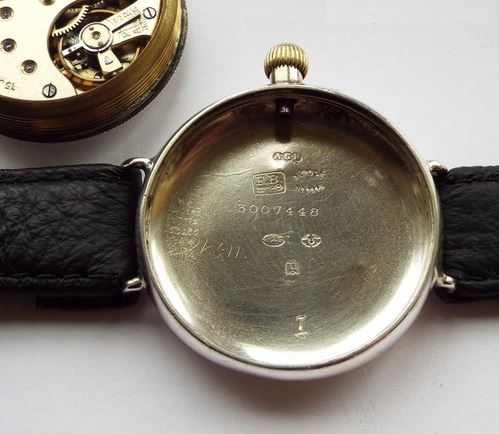
History
In 1300 King Edward I of England enacted a statute requiring that all silver articles must meet the sterling silver standard (92.5% pure silver). This standard was to be tested (assayed) and confirmed by marking the item with a leopard’s head. This was an early form of consumer protectionism. In 1327 King Edward III of England granted a charter to the Worshipful Company of Goldsmiths, marking the beginning of the company’s formal existence as the Assay office for England. Hallmarks evolved over time with additional marks being added to the leopard’s head.
Plate Offences Act
The Plate Offences Act of 1738 stipulated that all items of silver or gold that were traded in Britain must be hallmarked. This was meant to have included the cases of foreign gold and silver watches imported to Britain. However, this law was widely misinterpreted and largely ignored by customs and assay authorities. As it wasn’t rigorously policed, it was down to the foreign manufacturer or importer to decide whether or not to hallmark. However, this all changed with the Imported Watch Cases Bill of 1907. The Earl of Granard read the following statement in the House of Lords on 15 July 1907.
“My Lords, the necessity for this Bill has been brought about in a rather curious way. According to the Customs Act, 1842, all foreign plate imported into this country must be of the same standard as our own plate and must be hall-marked. For some reason the customs authorities have always considered that watch cases did not come within the meaning of the Act, and consequently up to the present time they have always been exempted from assay and marking. The result is that watch cases of all kinds have been brought into this country, and cases have been sold as gold and silver which were nothing of the sort. The Court of Appeal the other day ruled that watch cases were plate within the meaning of the Act, and the object of this Bill is to exempt from assay and hall-marking all watch cases which are at present in stock over here and which came into this country before 1st June last.”
Hallmark components
A British hallmark on silver or gold must have at least the first four specific separate marks listed below. Sometimes there are additional marks to do with excise duty or a monarch’s jubilee. These hallmarks apply to items made in Britain or those that have been imported. All four of these marks must be not present to be a legal British hallmark.
Sponsor’s or Maker’s Mark:
This is the first mark to be struck on an item and shows under whose registered name and details it was submitted to the Assay office for assaying. Every punch used to strike the sponsor’s mark was individually recorded at the Assay office. Strictly speaking, this is more correctly known as the Sponsor’s mark. There was no requirement for the manufacturer to submit an item for testing and frequently assay agents were used to submit items on the maker’s behalf. This is particularly the case for items that were produced abroad and imported to Britain.
Town Mark:
This shows the location of the Assay office where the item was tested and hallmarked. Note this does not necessarily indicate the place of manufacture, just where it was tested and hallmarked. Typically, for English-made watch cases, this is usually either a leopard’s head (London), an anchor (Birmingham), or an upright sword between three wheat sheaves (Chester).
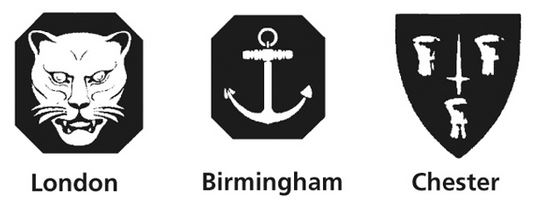
- The leopard’s head crown for any silver made in London prior to 1820.
- The leopard’s head uncrowned for any silver made in London after 1820.
- The crown for silver hallmarked in Sheffield.
- The anchor for silver hallmarked in Birmingham.
- The three wheat sheaves for silver hallmarked in Chester.
- The castle for silver hallmarked in Edinburgh.
- The tree, fish, bell, and bird for silver hallmarked in Glasgow.
- The crowned harp for any silver hallmarked in Dublin until 1806.
- The Hibernia for any silver hallmarked in Dublin from 1807 to the present.
Fineness Mark:
This shows the legal standard of purity of the metal. For sterling silver, this is the ‘lion passant’. For gold, it is either a crown and the carat fineness, e.g. a crown and 18 for 18-carat gold or, for the lower standards, the carat and decimal fineness e.g. 9 and ·375 for 9-carat gold. The mark does not show the specific results of the assay of an item. However, it does confirm that it is at least as fine as the standard marked.
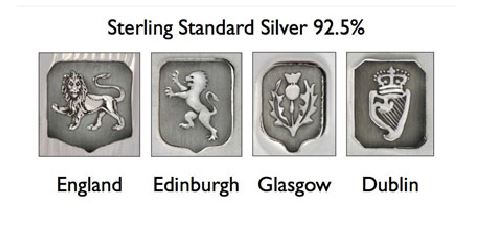
Date Letter:
This shows the year when the item was hallmarked. It is important to note that each Assay office had its own unique range of date letters. You must be able to identify the Town Mark to be able to correctly date an item. The date letter was no longer a requirement from 1999, which won’t affect current collectors of antique watches, but may in about eighty years. In the two examples below, the lion indicates sterling silver, the leopard’s head is for London and the date letters R for 1896 and L for 1906. It is worth noting that from 1700 to 1874 the date letter changed on the 29th of May. This means that every date letter crosses two years. Therefore a watch with a date letter for 1914 is, in reality, 1914/15. I use the earlier of the two dates on this website. From 1975 onwards the date letter changed on the 1st of January.

Foreign Mark
In Britain, gold or silver watch cases, regardless of the country of manufacture, should always have been assayed and hallmarked in a British assay office. However, the hallmarking of imported watch cases was not strictly enforced by Customs before 1907. A small number of foreign watches were stamped with an ‘F’ to indicate they were made abroad. However, the vast majority of foreign watch cases were imported into Britain either without hallmarks at all, or with hallmarks from their country of origin.
The local British watchmakers, were no doubt, attempting to defend ‘their’ brand and argued for the marking of foreign-made cases. In contrast, the foreign watch case makers did not want to have the risk of their product seeming inferior. Therefore many bypassed the British assay offices. British practice changed in 1907 when the hallmarking of foreign-made cases was strictly enforced by Customs. The hallmarks used by the assay offices on the foreign watch cases were clearly different from those used on watch cases made in the UK. For example, the London Assay Office town mark for watch cases made in Britain was a leopard’s head. The town mark used on imported watches became the zodiac symbol, Leo, on a crossed background in an oval shield.
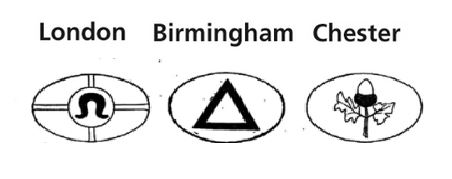
The new town marks were used from 1 June 1907 on imported watch cases to distinguish them from watch cases made in Britain. Another indication, for foreign-made silver cases, is that the silver standard is marked as 925 in an oval shield rather than by the traditional lion passant mark for sterling silver made in Britain.
Example
The image below has been taken from my J W Benson silver fusee pocket watch, 1883. I apologise for the quality of the image, but I am not a photographer. There was a considerable amount of zoom required to get the hallmarks visible. To accurately read hallmarks you really need a good light source and some magnification, such as a jeweller’s loupe. The heavy scratching in the photograph is actually very faint to the naked eye.
We can see that this case has the lion passant, which confirms it is sterling silver. The leopard’s head tells us that this was assayed in London. This then allows us to consult the date marks for London to determine that the year was 1883. Finally, the sponsor’s mark for J.W Benson is at the bottom.
I have recently added a post on Swiss hallmarks.
A list of additional posts regarding antique watches can be found on the Guides page.
Related content
Gold Traders – Gold hallmark wizard.

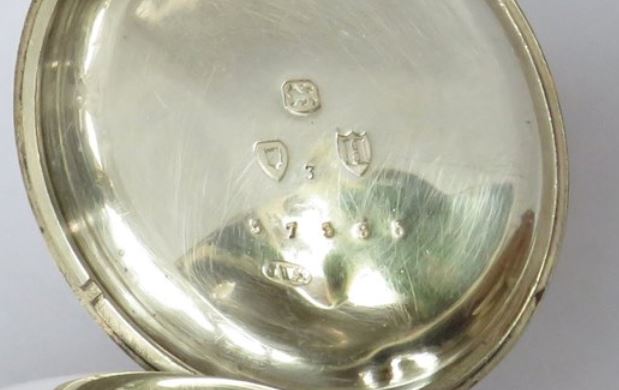
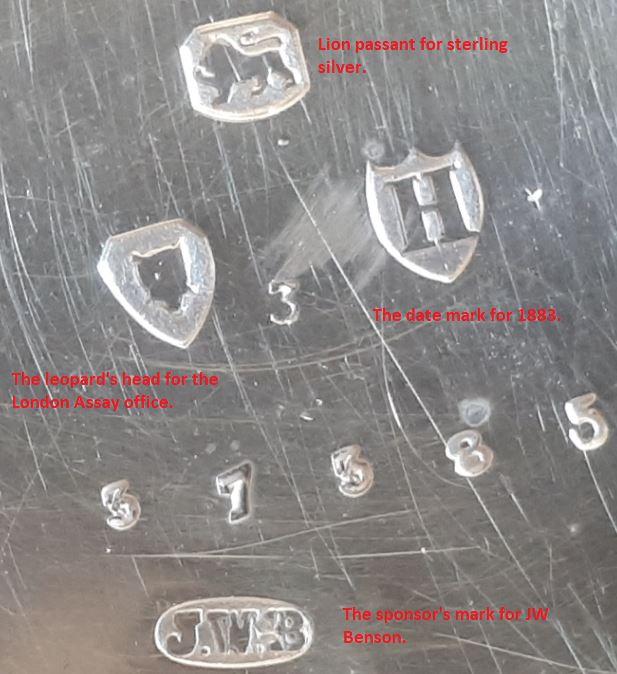
Hi, my name is Jamie Schaefer I live near Brisbane Qld Australia. I will get straight to the point!
I bought an old wind-up key mechanism silver, Birmingmhan JR Roman letter R 22 pocket watch.
I know obviously some of the hallmark’s meanings. I went to unwind two tiny screws & I held back from applying too much pressure. The hidden agenda was I know collectors like a bit of age if wanting to pass on! Could you please tell me the manufacturer, date and value, please.
Tar
Jamie Schaefer
Hi Jamie,
Based on the details you have supplied and assuming the case is silver, I think the watchmaker in question is Rotherham & Sons (JR – John Rotherham) and it dates from 1891. To determine the value, the best option is to look at recent auction results for similar watches. In general, watches were made in huge numbers and many still survive so they typically have a low value. Normally, the sentimental value far outweighs the monetary value. I hope this helps, Jason
Links:
Hi – is there any relevance to the finess mark for silver (lion passant) being in a different shape lozenge? I have a watch case with the same shape lozenge as shown in your picture above, but have been unable to find out anything specific.
Thank you
Hi Theresa, I have had a look into this in quite a bit of depth. The changes in the punch shape for the date letters were recorded in the assay offices. However, this is not the case for the finess mark. I cannot find any record of these changes. I think this was because the finess mark was static, but the date letters were reused. I hope this helps, Jason
Hi inherited a pocket watch it is silver
Stamp of a lion with 16 on top of this
Then the Sheild including the thistle in middle then H next to it then CH at the bottom, of to the side 3275 a think initials of jf I think ? Possible valuation??.
Hi Tracy,
The Thistle indicates that this watch case is from Edingburgh, Scotland. The H is likely to be the date mark, which is most probably 1913. The CH mark is most likely to be the Sponsor’s mark, but I cannot find any online reference. In terms of value, there are a few questions to ask. Which watchmaker made the movement? This might be engraved on the movement itself, which would require opening the case. Is it working? Is it keeping accurate time? If it isn’t working or keeping poor time, it is likely to need a service, which detracts from its value. In general, the sentimental value of antique pocket watches, far outweighs their monetary value. Look at similar sold antique watches on online auctions sites for an idea of its value. Thanks for taking the time to comment, Jason
I have a 14 kt gold Hampden watch circa1888 inlaid with Rubies and Diamonds and is listed on American Horology Archive as only 1being registered for that year of production
Hi William, it sounds like a nice antique pocket watch. I know very little about American brands, but please enjoy wearing it, take care of the watch and yourself, thanks for commenting, Jason.
You made some really good points on your post. Do the same hallmarks apply for gold? I have a gold JW Benson pocket watch that has passed down through the family. Will I be able to date the watch using the hallmarks?
Hi Felix, the hallmark system is similar for gold. There is a link in the Related content section that has a tool for dating using gold hallmarks. You should be able to accurately date the watch using the gold hallmarks. You can read about JW Benson in this post. Thanks for commenting.
Hi , i have recently obtained a family members pocket watch and the markings are
FT. Crown symbol . 18.
This is a kendal and dent pocket watch